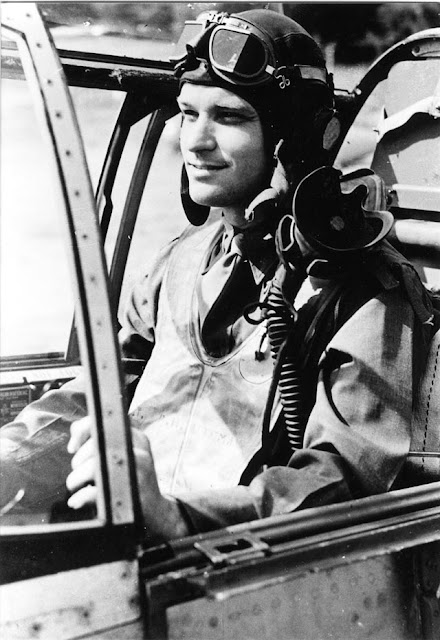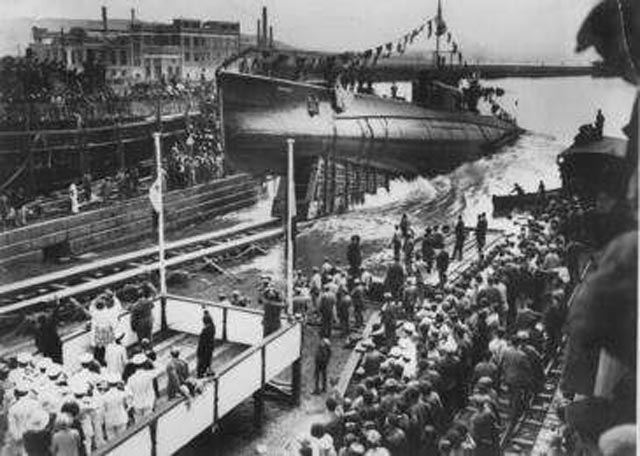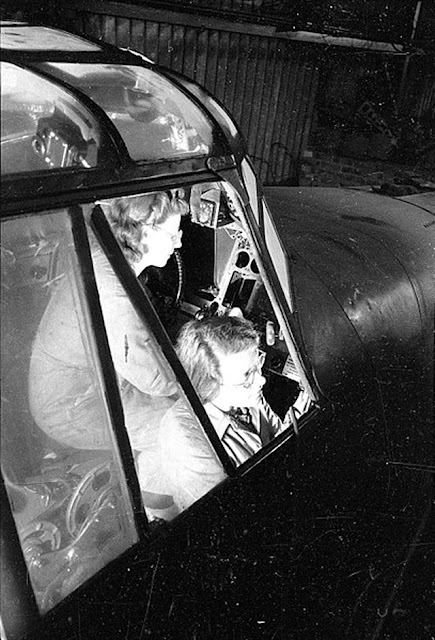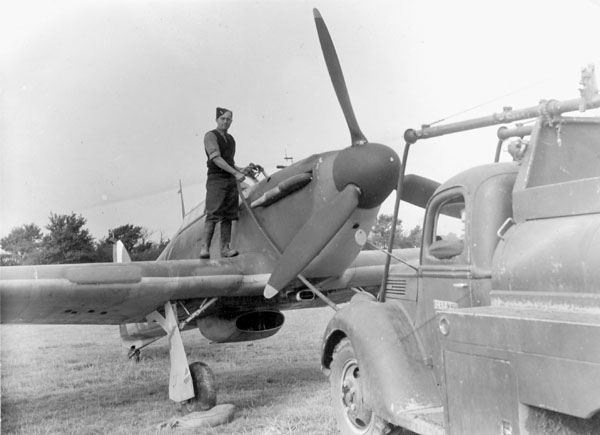Wednesday 18 March 1942
 |
| "HMT ADRONIE CAMIEL with a barrage balloon above her." 18 March 1942 in Milford Haven and Fishguard. © IWM (A 7908). |
The American Volunteer Group (AVG), or "Flying Tigers," are still causing the Japanese problems in Burma. At 07:55, they attack the Japanese airfield at Moulmein and destroy three bombers, two transport planes, and 11 fighters on the ground. The Japanese realize they need to beef up their air presence in Burma. So, during the day, the Japanese transfer 420 aircraft from recently conquered Malaya and the Netherlands East Indies to reinforce their forces in Burma.
 |
| "Motor Minesweeper J514." 18 March 1942. © IWM (A 9738). |
The United States' presence in Australia is still very light. Today, the US Army Air Force has a strength of 213 combat aircraft. This includes a dozen B-17 Flying Fortresses, 27 A-24 Dauntless dive bombers, various other medium and light bombers, 33 P-39 and 52 Bell P-400 Aircobras (export version of the P-39), 92 P-40 fighters, and assorted other transport and trainer aircraft.
 |
| Let's take a look at an average pilot. "Lt. Paul H. Bateman enlisted on 18 March 1942 at Fort Bragg, NC. Assigned to the 370th Fighter Squadron in April 1943, he completed his combat tour of duty in July 1944 with 301-1/2 hours and 1-3/4 aerial victories and 1-1/3 ground. Aircraft included P-51B CS-O 42-106926." American Air Museum UPL 38438. |
European Air Operations: The RAF is in the midst of an extended lull in operations. RAF Bomber Command sends five Wellington bombers to Essen but they return without attacking due to weather conditions.
 |
| SS Kassandra Louloudis, lost on 18 March 1942. |
British 1547-ton freighter Ebro, carrying a load of fish from Reykjavik (Iceland) to Hull (GB), runs aground in Strathberg Bay, 2 nm NW of Rattray Lighthouse (Scotland, UK) and is written off. There is no report of any casualties.
U-653 (Kptlt. Gerhard Feiler), on its second patrol out of Brest, is lurking along the North Atlantic route near Convoy SL-119 when it is spotted by a patrolling Liberator aircraft of Squadron 120/F. The submarine crew realizes it has been spotted and quickly dives, but it leaves one man topside who is lost. The U-boat sustains damage during the attack and barely makes it back to Brest on 30 April.
 |
| Italian submarine Tricheco, shown being launched in 1931, was lost on 18 March 1942. |
The Luftwaffe continues its daily raids on Malta today. Junkers Ju 88s begin the barrage at around 08:00, and air battles continue over the island throughout the day. Both sides suffer losses, and the Germans succeed in further damaging Hal Far Airfield and other key points.
 |
| "Rear Admiral Robert Lindsay Burnett, OBE, addressing the ship's company of HMS ASHANTI. On the right just below the Admiral is the ship's captain, Commander R G Onslow, RN." 18 March 1942. © IWM (A 7972). |
US/Chinese Relations: The United States Navy leases its river gunboat Tutuila to the Chinese government for the duration.
US/Australian Relations: General Brett, now technically General MacArthur's deputy even though MacArthur is still en route from Darwin, announces that the USAAF and Australian Air Force (RAAF) will fly together as a combined force.
British Military: Vice Admiral Lord Louis Mountbatten is named Chief of Combined Operations.
US Military: Two companies of the 182nd Infantry Regiment and a company of engineers arrive on Efate Island in the New Hebrides to construct an airfield.
 |
| Polish Jew Abraham Weinberger (No. 25986) of Tarnów, a political prisoner, was executed at Auschwitz on 18 March 1942. |
Take all people of Japanese descent into custody, surround them with troops, prevent them from buying land, and return them to their former homes at the close of the war.Milton S. Eisenhower (the brother of Dwight) is appointed as the first director despite the fact that he is largely against the whole internment scheme. He writes his former boss, Agriculture Secretary Claude Wickard:
When the war is over, and we consider calmly this unprecedented migration of 120,000 people, we, as Americans, are going to regret the unavoidable injustices that we may have done.Eisenhower, unable to cut back the program as he desires, will resign on 18 June 1942. However, during his brief tenure, he does manage to implement some reforms, such as raising wages for the interned people and establishing an internee advisory council.
The WRA's main objective is to take internees from their temporary "assembly centers" established by the military's Wartime Civilian Control Administration (WCCA) and move them into permanent camps. This is done successfully at ten camp locations, most of which are on tribal land, though often the arriving internees themselves have to help with the camp construction.
American Homefront: "Reap the Wild Wind," directed by Cecil B. DeMille and starring John Wayne and Ray Milland, hits theaters today. While one of Wayne's lesser-known films, "Reap the Wild Wind" is very successful and helps to cement his status as a major Hollywood star. It also is one of Wayne's more unusual films in that he plays a very dark character that is very similar to his later role in "Wake of the Red Witch" (1948). Paulette Goddard also stars.
 |
| "Two women workers sit inside the cockpit of an aircraft as they wire up the pilot's instrument panel, at a factory somewhere in Britain. According to the original caption, one woman is a GTC (Government Training Centre) trainee, and the other has been recently transferred from the canteen." 18 March 1942. © IWM (L 346). |
March 1942
March 1, 1942: Second Battle of Java Sea
March 2, 1942: Huge Allied Shipping Losses at Java
March 3, 1942: Japan Raids Western Australia
March 4, 1942: Second Raid On Hawaii
March 5, 1942: Japan Takes Batavia
March 6, 1942: Churchill Assaults Free Speech
March 7, 1942: British Defeat in Burma
March 8, 1942: Rangoon Falls to Japan
March 9, 1942: Japanese Conquest of Dutch East Indies
March 10, 1942:US Navy attacks Japanese Landings at Lae
March 11, 1942: Warren Buffett's First Stock Trade
March 12, 1942: Japan Takes Java
March 13, 1942: Soviets Attack In Crimea Again
March 14, 1942: The US Leans Toward Europe
March 15, 1942: Operation Raubtier Begins
March 16, 1942: General MacArthur Gets His Ride
March 17, 1942: MacArthur Arrives in Australia
March 18, 1942: Japan Attacks In Burma
March 19, 1942: Soviets Encircled on the Volkhov
March 20, 1942: "I Shall Return," Says MacArthur
March 21, 1942: Germans Attack Toward Demyansk
March 22, 1942: Second Battle of Sirte
March 23, 1942: Hitler's Insecurity Builds
March 24, 1942: Bataan Bombarded
March 25, 1942: Chinese Under Pressure in Burma
March 26, 1942: Win Or Die, Vows MacArthur
March 27, 1942: The Battle of Suusari
March 28, 1942: The St. Nazaire Commando Raid
March 29, 1942: The Free Republic of Nias
March 30, 1942: Japanese-Americans Off Bainbridge Island
March 31, 1942: Japanese Seize Christmas Island





